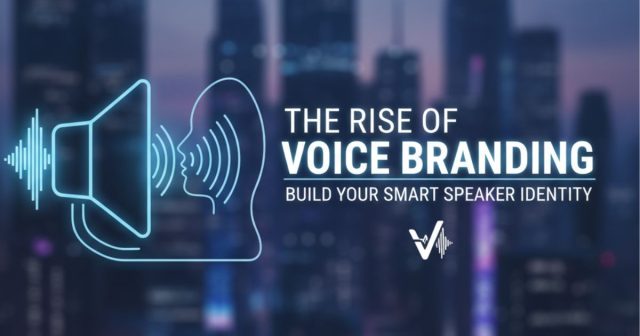As voice assistants like Amazon Alexa, Google Assistant, and Apple Siri become everyday fixtures in homes and workplaces, brands have a unique opportunity to shape their identity through sound. Voice branding uses auditory branding elements—including tone of voice, sonic logos, audio cues, and music motifs—to create memorable and emotionally resonant experiences. By integrating these strategies, companies can strengthen brand recognition, improve customer engagement, and deliver cohesive experiences across smart speakers, IoT devices, and voice-enabled platforms.
Stay with us, we’ll explore why voice branding matters, the core components of successful auditory identities, practical steps for implementation, and emerging trends in voice marketing, audio branding, and digital brand strategy.
What Is Voice Branding?
Voice branding refers to the strategic use of audio elements to communicate a brand’s personality and values. While traditional branding relies on visual logos and color palettes, voice branding expands a brand’s presence into the aural realm. Core elements include:
- Sonic Logo: A short musical or soundbite that instantly identifies the brand, much like Intel’s four-note chime.
- Voice Persona: The human or synthetic voice used in interactions, defined by tone, pace, accent, and emotional inflection.
- Audio Style Guide: A documented set of rules covering vocal qualities, background music, sound effects, and use cases.
Why Voice Branding Matters Now?

Smart speakers like Amazon Echo, Google Nest, and Apple HomePod are projected to be in over 200 million homes worldwide by 2026. With voice queries surpassing 50% of all searches on some platforms, customers expect seamless, branded audio experiences. Voice branding offers several advantages:
- Differentiation: In a crowded marketplace, a distinctive voice identity sets you apart.
- Emotional Engagement: Sound triggers deeper emotional responses than visuals alone.
- Consistency Across Channels: Extend brand cohesion from websites and video to in-car systems and wearables.
- Accessibility: Voice-first interfaces improve inclusion for visually impaired or multitasking users.
Elements of Effective Voice Branding
1. Sonic Logo
Your sonic logo should be brief (1–3 seconds), memorable, and aligned with brand values. It can be melodic, percussive, or an abstract sound cue. Test several variations in focus groups to gauge recall and emotional impact.
2. Voice Persona
Decide between a human voice actor or a custom text-to-speech (TTS) solution. Consider attributes like gender, age, accent, and speaking style. Document the vocal range (pitch, pacing, inflection) that best conveys your brand’s personality—whether playful, authoritative, warm, or energetic.
3. Background Music & Sound Effects
Select music beds and effects that complement your voice persona without overshadowing it. Use subtle atmospheric tones for menu prompts and dynamic stingers for transitions. Maintain consistent volume levels to ensure clarity.
4. Audio Style Guide
Compile your sonic assets, usage rules, and sample scripts into a comprehensive guide. Include dos and don’ts for voice-over talent, other stakeholders, and third-party agencies to ensure brand coherence.
Crafting Your Brand’s Auditory Identity
Follow these strategic steps to build a compelling voice brand:
- Assess Your Brand Personality: Revisit your brand’s tone, values, and target audience personas to define the emotional palette of your voice identity.
- Audit Existing Audio Touchpoints: Collect samples of current jingles, voice-overs, podcasts, and IVR prompts. Identify inconsistencies and gaps.
- Co-Create With Stakeholders: Work with marketing, design, and customer service to align on key messages, tone, and desired customer feelings.
- Prototype & Iterate: Produce multiple sonic logo drafts and voice recordings. Conduct user testing to refine pacing, pronunciation, and music styles.
- Finalize & Document: Lock down assets and produce an audio style guide. Train internal teams and external partners on proper usage.
Implementing Voice Branding on Smart Devices

Once your assets are ready, integrate them across voice platforms:
- Custom Alexa Skills & Google Actions: Implement your sonic logo at launch, use branded voice prompts in menus, and interject audio cues to signal success or errors.
- Mobile App Integration: Embed voice interactions within your iOS and Android apps. Include voice-guided tutorials and notifications.
- Physical Touchpoints: In retail spaces, use ambient audio zones and smart-speaker demos. For events, create immersive audio booths featuring your brand voice.
- Website & Video Content: Incorporate your sonic logo as an intro/outro on video ads and on-site tutorials. Use the voice persona for interactive chatbots and explainers.
Learn More: What Is Brand Voice in Marketing and Why It Matters
Measuring Success & Key Performance Indicators
Quantify the impact of voice branding with metrics such as:
- Brand Recall: Percentage of users who recognize your sonic logo or voice persona in blind tests.
- Engagement Rates: Interactions per session on voice apps, completion rates for voice tutorials, and retention metrics.
- Customer Sentiment: Analyze voice reviews, social mentions of your audio brand elements, and Net Promoter Score (NPS) changes.
- Conversion Lift: Track sales or sign-ups initiated via voice commands compared to baseline channels.
Future Trends in Voice Branding

Stay ahead by watching emerging developments:
- Hyper-Personalization: AI-driven voices that adapt tone and content based on individual user data and context.
- Multimodal Experiences: Seamless transitions between voice, visual, and haptic feedback across devices.
- Spatial Audio & 3D Sound: Immersive soundscapes for virtual commerce and branded AR/VR environments.
- Voice-First Commerce: Frictionless shopping journeys initiated and completed entirely via voice commands.
Conclusion
Voice branding is more than a novelty—it’s a strategic imperative for any brand seeking to remain relevant in an increasingly audio-driven world. By defining a clear voice persona, crafting a memorable sonic logo, and implementing consistent audio experiences across smart speakers and other touchpoints, you can build deeper emotional bonds and unlock new growth opportunities. Start your voice branding journey today and prepare to be heard—literally—by your most loyal customers.




